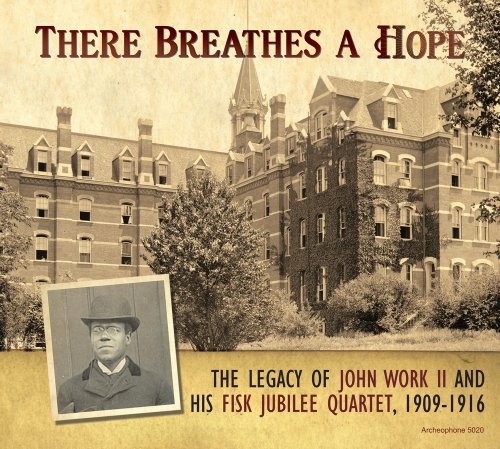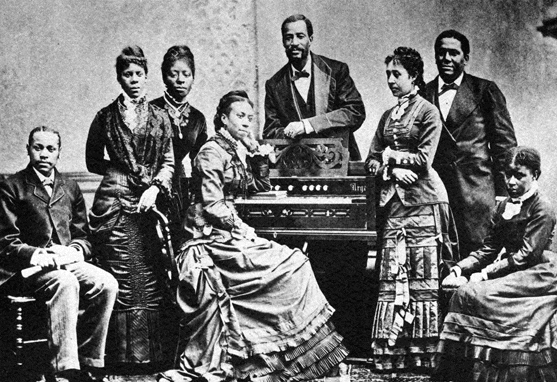'A History Lesson For The Ages'
By Bob Marovich
In the December 24, 2010 issue of The Wall Street Journal, reviewer Terry Teachout declared There Breathes a Hope: The Legacy of John Work II and His Fisk Jubilee Quartet, 1909-1916 to be "the most important historical reissue of 2010."
I couldn't agree more.
There Breathes a Hope combines jubilee singing, rare photography, expert commentary and album design to produce what is more than a compilation: the two-CD set is a history lesson for the ages.
The package from Grammy-winning Archeophone Records opens with the Fisk University Jubilee Quartette's historic first sessions for the Victor Record Company in 1909 and 1911. It concludes with the 1915-16 Columbia recordings and one of two known discs produced for the Richmond, Indiana-based Starr label in 1916.
The Fisk Jubilee Quartet, led by John Work II, 1909: 'Little David, Play On Yo' Harp'/'Shout All Over God's Heaven'While all of the recordings are superb, the real treats are smack-dab in the middle: nine cylinders from the quartet's December 1911 session for the Edison Phonograph Company. These rare Edison four-minute cylinders have not been reissued until now. Seven were discovered in pristine condition by Ken Flaherty, Jr., a collector and the album's co-producer, at a flea market ten years ago.
Unlike the Victor and Columbia recordings, the Edison cylinders capture the vibrant quartet when it was graced with the soon-to-be concert singer Roland Hayes as second tenor. Listening to the crystal-clear high notes of Hayes and John Work II on selections such as "All Over This World" and "My Soul is a Witness" is magical. The superior audio quality of Edison product bestows a brightness to the performances that pre-electric Victor and Columbia could not capture, although Columbia came closest. In any event, the chance to hear these nine cylinders are alone worth the purchase price.
Equally inspiring is hearing the quartet perform beyond the three-minute limitation of the ten-inch phonograph record. For example, "Swing Low Sweet Chariot" clocks in at 4:34. This is as close to hearing the quartet performing the arrangements in concert as we in the twenty-first century are likely to experience.
The Fisk Jubilee Quartet, led by John Work II, 'I Couldn't Hear Nobody Pray' (1909)The famed Fisk Jubilee Singers were too large an ensemble to capture via acoustic recording horns, so four gentlemen were assembled as the Fisk University Jubilee Quartet to make recordings. Thanks to Work's direction, the group was known for its tight a cappella harmonies, tenor leads and vibrant rhythms on selections such "The Old Ark," "Golden Slippers," "Brethren, Rise Shine," "Peter on the Sea," and "I Know the Lord Laid His Hands on Me." On "The Ole Ark," from the Edison session, one of the members punctuates the energetic singing with quick wordless exhortations, anticipating the enthusiastic interjections common to gospel music.
Not all of the 43 selections on There Breathes a Hope are spirituals, or even sung. Like most quartets of the day, the group performed secular as well as sacred pieces. Included here is the group rendering Stephen Foster's "Old Black Joe" in solemn tempo. Four selections feature Rev. James A. Myers reciting Paul Laurence Dunbar poems, including "When Malindy Sings" and "In the Morning."
Snippets of a 1983 interview researcher and author Doug Seroff conducted with Jerome I. Wright, one of the last surviving members of the Fisk group to work under John Work II, provide interesting insights into the singers' focused dedication to their craft.
The original Fisk Jubilee Singers, shown here in an 1899 photo, were led by bass singer F.J. Loudin (standing, center)The handsomely illustrated album includes than 100 pages of rich, discographical information; transcriptions; and Seroff's fascinating and detailed essay on the Fisk group and its indefatigable organizer, John Work II. Work helped to revive the spirituals tradition at Fisk and went on to contribute significantly to their preservation as a song collector and arranger. Tim Brooks wrote the essay's prologue; his collaboration with Archeophone's Richard Martin and Meagan Hennessey on Lost Sounds, an audio companion to his major work on early African American recording artists, earned the team its first two Grammy Awards in 2006. Not surprisingly, the booklet accompanying There Breathes a Hope has been nominated for a Grammy in the "Best Album Notes" category.
There Breathes a Hope provides musicologist and enthusiast alike a front row seat to trained vocal harmony as it was performed a century ago, when, as Wright explained proudly, "we made it sound like a pipe organ."
For more gospel news, interviews and reviews, visit Bob Marovich at The Black Gospel Blog
Founder/Publisher/Editor: David McGee
Contributing Editors: Billy Altman, Laura Fissinger, Christopher Hill, Derk Richardson
Logo Design: John Mendelsohn (www.johnmendelsohn.com)
Website Design: Kieran McGee (www.kieranmcgee.com)
Staff Photographers: Audrey Harrod (Louisville, KY; www.flickr.com/audreyharrod), Alicia Zappier (New York)
E-mail: thebluegrassspecial@gmail.com
Mailing Address: David McGee, 201 W. 85 St.—5B, New York, NY 10024




